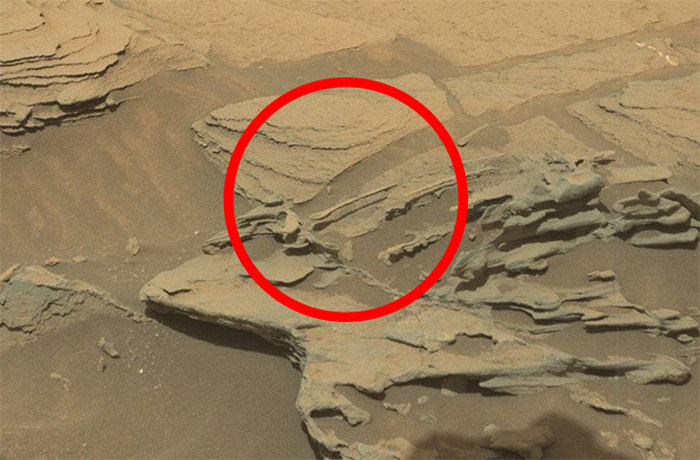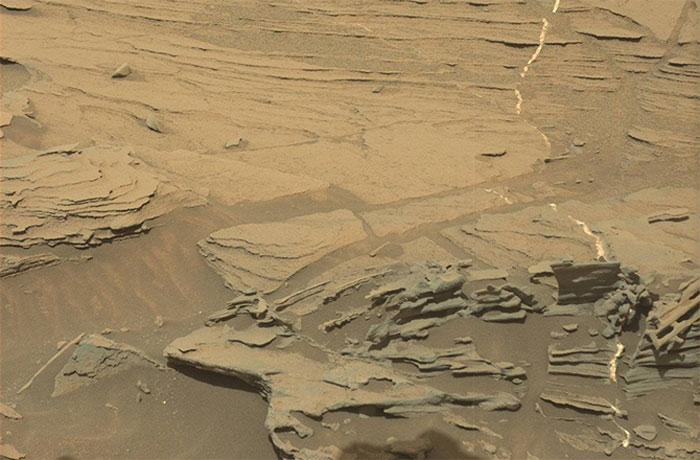.

A small rocky overhang on the Martian surface as seen by NASA's Mars rover Curiosity's Mastcam on sol 1089 (Aug. 30).
NASA/JPL-CALTECH
We’ve seen “rats,” “yetis,” “faces,” even “elephants” on Mars, but this new image captured by NASA’s Mars rover Curiosity is one of the most fascinating views of a rock formation on the Martian surface yet.
Sure, like these other examples I’ve included in “quotes,” this “spoon” is yet another wonderful example of Mars pareidolia, but with a twist.
Top 10 Weirdest Mars Illusions and Pareidolia
This latest Mars oddity was spotted by members of the UnmannedSpaceflight.com forum in an image captured by Curiosity’s Mastcam on sol 1089 of the mission (Aug. 30). Once you spot it, it becomes obvious; it really does look like a spoon hanging in the air, just above the surface of some layered rock. But as Mars is devoid of any civilization, advanced or otherwise, that is capable of manufacturing said spoon, there’s probably a more logical answer.
The logical answer, however, is still pretty awesome.
Pareidolia is a psychological phenomenon that makes our brains interpret some kind of random visual stimulus as a familiar pattern or object. A famous example of space pareidolia is the “Face of Mars”, where a mesa (a hill) in the Cydonia region of Mars had the pattern of a human face in early Viking spacecraft observations. Now we have high-resolution cameras in orbit about Mars, we have since proven that the face was nothing more than a product of some fortuitous shadows and psychological trickery.
ANALYSIS: Curiosity Has Hit a Martian Mineral Jackpot
Down on the Martian surface, recent images beamed back by Curiosity have been awash with rocks of all shapes and sizes — needless to say, the high-resolution imagery from the mission has been a hotbed of pareidolia, leading to numerous conspiracy theories — the most recent being a rock shaped like an iguana, which has taken social media by storm.
But now we have (what appears to be) a spoon (and it REALLY looks like a spoon, just sayin’) jutting out from rocks on Mars. Undoubtedly a great example of pareidolia, but also an insight to the wonderfully calm Martian environment and fascinating geological processes.
Windy Erosion
On Earth, if the conditions are right, rocks, shaped by hundreds of thousands or even millions of years of wind erosion, can appear unnaturally balanced or shaped (such as Colorado’s Garden of the Gods or Utah’s Balanced Rock). But on Mars, where the atmosphere is thin, gravity is weak and other erosion processes are few, wind action can create even more elegant structures than on Earth. Aeolean processes (wind action) dominates Mars, producing everything from small dust devils to planet-wide dust storms. This windy activity creates vast dune fields and snaking valleys — it can also create tiny arches and overhangs, like this “spoon.”
.

Wider view of Curiosity's observation including the "spoon."
NASA/JPL-CALTECH
ANALYSIS: Is Mars Infested With Pareidolia Rats?
In addition, we already know from Curiosity’s analysis of various rocky outcrops at the base of Mount Sharp, mineral veins are commonplace. Often, these veins jut high above the surrounding, soft sedimentary rock. These veins have been found to be rich in calcium sulfate and other examples have shown evidence of episodic flows of water in Mars’ ancient past. Interestingly, in this Curiosity observation, a bright vein of material can be seen snaking from top to bottom, to the right of the image.
And these veins could contribute to reinforcing small structures like this floating “spoon.”
Of course, it could be a trick of the light, creating what appears to be a shadow beneath the “spoon,” but looking at the direction of sunlight on the surface in this Curiosity observation, it appears as if it has been carved out of the sedimentary rock and aligned with rocky layers that can be seen tracing lines across the dusty surface.
So, once again, this little nugget of Mars pareidolia is a rock that happens to be shaped like a spoon. But it’s a fascinating rock, and an awesome find, providing some geological hints as to the erosion processes that can etch out such delicate formations on the surface of the Red Planet.
Quelle: D-News
5793 Views
